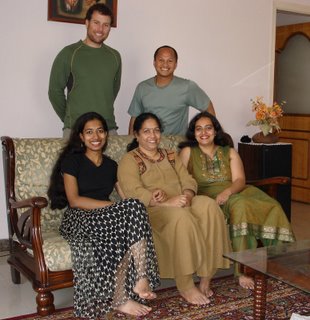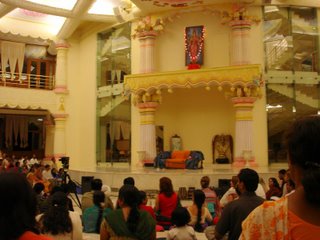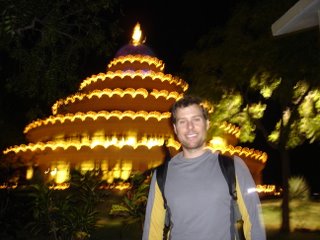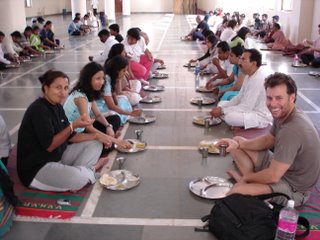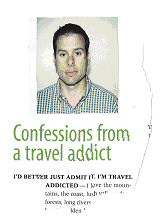Roopa's Choice

(In the hospital media room with Roopa, Simran and Shubi watching Covey's "8th Habit" while Roopa receives treatment.)
Back in Ft. Cochin for one night before my return to Bombay, I awoke at 5:26 a.m. wondering what room I was in. I thought I knew, but the walls were in the wrong place and in the dark, I could not orient myself. My hands stretched out feeling the cool walls on two sides of me. They were not where I expected to find them. Mildly disturbed by my disorientation, I lifted my head from the pillow to get a better perspective on the room.
Allowing my eyes to focus and feeling around with my hands, I realized that I was completely sideways on the bed, not the position in which I had fallen asleep. Surprised at my twisted positioning, I realized that I was restless thinking about Roopa. Earlier in the evening, I received a call from Roopa’s phone, but it was Shubi on the line confirming my arrival information and arranging for my transportation from the airport. For a moment, she handed the phone to Roopa, who sounded cheerful, but with less energy than her usual self. It was a brief conversation, lasting only long enough to share that we were looking forward to seeing each other again.
Before going to sleep that night, Roopa was on my mind as I mentally and physically began preparing myself for seeing her again, this time under less festive circumstances. When we first met, Roopa was full of energy, bright eyed and excited from her three days at the Silver Jubilee (25th Anniversary) of the Art of Living Human Values Conference in Bangalore. Within less than five minutes of meeting, she had taken me under her spiritual wing and assumed responsibility for my safety, health and growth while in India. She made me feel at home in a place very far from it. Now I was returning to that home, but all was not how I had left it.
These thoughts and how to approach my return occupied my thoughts as I lay in bed waiting for sleep to return. No luck with my date in dreamland, I got up to apply my anxious energy to organizing and packing. Traveling solo, I did not have the benefit of valued conversation from my friends and family for a different perspective. I sat down at the guesthouse computer and checked e-mail finding comfort in something familiar. Dealing with illness, life and death was unfamiliar and uncomfortable territory for me.
Fortunately, there was a well spring of e-mails from friends and family that energized me. Many reiterated their prayers for Roopa’s healing which, when conveyed to her, brought extended smiles to her face with joyful bursts of energy. One e-mail in particular counseled me in a way that I needed, “Remember to treat her like she is living, not dying,” it read. That was the perspective I was racking my brain for throughout the night.
For the next five days, there wouldn’t be any sightseeing, no visits to ashrams, no yoga classes, no meals out, just being. Within days of my departure from Bombay in early March, Roopa’s life and all those around her, especially Shubi and Simran, took a dramatic turn. The delicate balance between life and death, usually occupying a backseat to daily routine, was now front and center on everyone’s mind.
Arrival in Bombay
Walking out of the airport, luggage in tow, I was reminded of my first night arriving more than five weeks ago when I was hoping that someone in the crowd outside of the terminal was there for me. This time I breezed through the airport as if I had been there a hundred times, exiting the terminal with the confidence that Manosh, one of the Gupta’s drivers whom I had met before, would be waiting for me. Scanning the crowd only once, I spotted Manosh’s smile in the back row of the crowd as we waved at each other.
Climbing into the car I knew, driving down the streets I recognized, we were off to run a few errands and then return to the Gupta condominium in the “Serenity Heights” building. An hour or so later, I was back at the condo where Bharti, a reiki massage therapist tending to Roopa, greeted me and explained that Roopa was resting. I took a seat at the dining table where a large lunch of five or six dishes was served by the Gupta cooks and household helpers. The food was always amazing at the Gupta’s with a selection that rivaled the menu of many restaurants.
Midway through my lunch, Shubi joined me having just woken from an afternoon nap. As expected, she was rocked by the news of her mother’s recent diagnosis and was still coping with the fall out. Having dealt with the news now for three weeks, she had found her stride and roll in assisting her Mom back to good health. The Gupta daughters, 23 and 24, were strong women, both well educated and having senior managerial positions within the family dealerships and workshops. Roopa had raised them with strong self esteems and independent can-do attitudes.
A half hour after lunch, Bharti came to tell me that Roopa was ready to see me. Excited and now firmly grounded, I walked into Roopa’s bedroom where she was resting under a patchwork designed quilt comforter. She looked peaceful and cracked a warm smile as I entered the room. I walked over to her as she sat up and gave her a hug. Without missing a beat, she immediately wanted to hear about my trip.
“How was the ashram?,” she wanted to know first.
I went into great detail about my experience as I knew she could relate, reliving her own experiences with several Art of Living courses she had taken. Roopa was an Art of Living veteran. She had met Guruji and was well connected to his network. It was this network and the powerful energy of spirit that now served as a valued source of strength.
When I finished my ashram story, Roopa was quick to inquire about the yoga festival in Rishikesh which lead to the first slideshow of pictures on my computer. She was delighted at the pictures of Guruji and the other yogis visiting the festival. The pictures energized her, speaking to her soul, reinvigorating her connection to spirit. Two hours or more into our catch-up session, I could tell Roopa was tired and Simran was heading to the gym, so I seized the opportunity to tag along.
At the age of 24, Simran runs the human resources operations at the family auto workshop. She works six and sometimes seven days a week. Attending evening kick-boxing and spin classes are essential to her stress management. Now faced with her Mom’s illness, she needed the classes more than ever. Unzipping my pant legs to convert my cargo pants to shorts, I took advantage of the weight room while Simran took her class.
On the way home from the gym, we had a chance to catch-up on her feelings about her Mom’s illness. Obviously upset, like Shubi, Simran had now settled into her role in nursing her Mom back to good health. She had been through it before with Roopa’s fight with breast cancer, but that was only a year and a half ago, and she was not expecting cancer to return so soon, if at all. Simran’s concern now was the people coming to visit Roopa. She explained that some family members did not share the same spiritual outlooks as Roopa, reminding me of what Bharti had explained to me four weeks earlier regarding the difference between Americans and Indians, i.e., “Americans live to live and Indians live to die.” It was a cultural mindset revolving around karma and fate.
Returning to the condominium, Simran’s concern was self evident. A few of Roopa’s relatives had gathered at the condo. A somber mood filled the air that was not present earlier when Roopa and I first re-connected. Mobiles were ringing and everyone was physically present, but mentally distracted. Roopa was surrounded by bodies, all of whom were there because of Roopa, but they seemed lost, unsure of what to do, or mourning with long faces as if resigned to a pre-destined fate for Roopa. I wasn’t sure how much of it was cultural versus general human nature. Sometimes it is the serious illness of a loved one that triggers an uncomfortable internal reminder of our own mortality.
Death is the great unknown, feared by many, who despite it’s inevitability wait until the inevitable knocks at their body’s door before arranging their spiritual affairs. All of the major world religions offer a belief system, a vision for the afterlife. Even in India, a country where religion and spirit seemingly appear on the dash of every car, a temple in every home and many television stations devoted to faith, word of cancer is a sharp reminder of life’s expiry. And everyone reacts differently. Fear rises in some, the will to fight in others, and the urge to flee for some running away from the thoughts of losing a loved one or perhaps the thought of their own mortality.
From the serious and strained looks on many of the visitor’s faces, they were understandably upset, but also seemed to be pre-maturely mourning a loss, all of which was contrary to Roopa’s plan. She knew it was going to be her choice, not theirs. Roopa was not dying, she was living joyfully with a smile on her face. Although more tired than usual as was to be expected, Roopa was gearing up to fight, to commit herself to beating cancer physically, mentally and spiritually. Having spent many years looking inward and practicing Kriya yoga daily, her spirit was strongly rooted and nourished by a connection with the Divine. Some of those around her, however, seemed less comfortable with Roopa’s condition, perhaps uncomfortable with the concept of death itself or subscribing to the cultural belief of karmic fate.
A recent outsider turned insider, I was not immune from uncomfortable feelings about illness and death, but with the e-mail support of family and friends, lots of time contemplating my return to Bombay and actually meeting with Roopa, my attitude toward life and death was morphing by the minute. Roopa has a grounding force bringing calm and serenity to any situation, good or bad. Meet her and you are instantly drawn to her spiritual bliss, her peaceful spirit. Friends, family and strangers rely on her for support, advice, wisdom and soulful nourishment, things she will now need to carry her through the uncomfortable side effects of chemo and blocking the energy of others resigned to karmic fate.
When the family members left the condo, Roopa and I had some time alone. A CD from the Art of Living played softly in the background while we talked about the attitude required to survive. We were speaking the same spiritual language as I was fresh from completing the Art of Living basic course. Our discussion centered around being 100% committed, a requirement from minute one in the Art of Living basic course and each course thereafter. Fathima had made clear, “You must give 100%. There is no such thing as try.” And that principle was more true than ever for Roopa.
A day earlier than prescribed, another round of chemo was scheduled for the following morning as the doctor would be leaving town and would not be available to monitor treatment. While I was feeling strong in my ability to support Roopa, knowing that she would receive another dose of the toxic drugs did not set well with me. Just after midnight, I returned to my bedroom at the Gupta bungalow while Roopa tried to get some rest.
My First Chemo
The following morning, Shubi phoned and gave me the plan for the day, “I’ll send a driver for you, we’ll have breakfast, stop by the showroom (meaning car dealership) and go to the hospital to see Mom.” That sounded fine, but I was again feeling a bit anxious about one, going to a hospital, and two, unsure of what I would feel watching chemo therapy administered. I didn’t know what it involved, but I knew it wasn’t pleasurable.
True to plan, Shubi and I went about town accomplishing errands and arrived at the women’s only hospital as Roopa was half an IV bottle into her chemo session. Entering the hospital I began to feel queasy, losing my ground as I took on energy, real or imagined, from the hospital. Each step further into the hospital, I asked for the strength to continue. I was way out of my comfort zone, something which I often craved, but this experience was rattling my cage.
The hospital setting was peaceful and unlike most hospitals I had visited. There were Buddha, Ganesh, Krishna and other religious and spiritual symbols, statues and pictures throughout. Entering the room, I was half in body and half out as I followed Shubi into the treatment room. As usual Roopa was cheerful, welcoming and smiling. She had just eaten and moved to one of two beds in the room. True to character, Roopa immediately inquired if we had eaten, again thinking of others.

(On the hospital rooftop, ringing a bell for Roopa in the temple garden.)
Five minutes into our visit, my shock began to wear off and I eased back onto the other bed in the room. A television was on and, unbeknownst to her, I looked to Shubi for cues on how to act. She was relaxed flipping through channels while Roopa laid back receiving treatment occasionally chatting with nurses as they entered to check her progress. I was the only anxious one in the room of old pros.
We spent the afternoon, into the early evening at the hospital as Roopa received two full IV bottles of the chemo drug. When the treatment was completed, the doctor removed the needle from her port, surgically inserted in her chest last week to deliver the drugs more effectively. Zapped of energy, but in good spirits, Roopa walked out of the hospital to make the hour plus drive home, but not without first stopping to find the doctor to thank him. She had received treatment at the same hospital the first time she battled cancer. She was well known by many of the nurses, and from the expressions and actions of all who came to see her, loved by them as well.
On the ride home, recognizing that I had been in the hospital most of the day, Simran asked, “Todd, were you bored today?” I thought about it for a moment, as I was still processing the day’s events. Astute and in tune as usual, as I began to speak, Roopa nodded in agreement echoing my sentiments precisely saying, “This is a part of the spiritual journey too.” And she was right, this was as much a part of my trip as visiting Rishikesh, Bangalore or any other physical place for that matter. While I suspect the lesson plan was designed long before I was aware, the classroom of life was in session and I was sitting in the front row.
Completely drained, I returned to the bungalow for the night to recharge. This was the most challenging curriculum I had had in a long time. To fully live life, you must first appreciate death, not dwell on it, just recognize and honor the value it adds to each day of life. Then just breathe and enjoy.


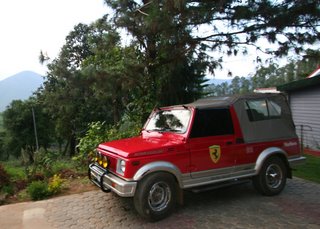









 (Laundry day at the canal's edge.)
(Laundry day at the canal's edge.)







